In-Depth Case Study: Contract Law Analysis, Scenarios, and Obligations
VerifiedAdded on 2023/04/11
|14
|3759
|415
Case Study
AI Summary
This case study delves into various aspects of contract law, including the essential elements of a valid contract such as offer, acceptance, consideration, intention to create legal relations, certainty, and capacity. It differentiates between bilateral and unilateral agreements, contracts under seal and simple contracts, written and verbal contracts, and face-to-face and distance selling contracts. The study further explores express, implied, and innominate terms within contracts, illustrating their significance through practical scenarios. It analyzes scenarios involving contract breaches, liability, and the interplay between contract law and tort liability, particularly negligence. The landmark case of Donoghue v Stevenson is cited to highlight the elements of negligence and the establishment of duty of care. The document is available on Desklib, a platform offering study tools and solved assignments for students.
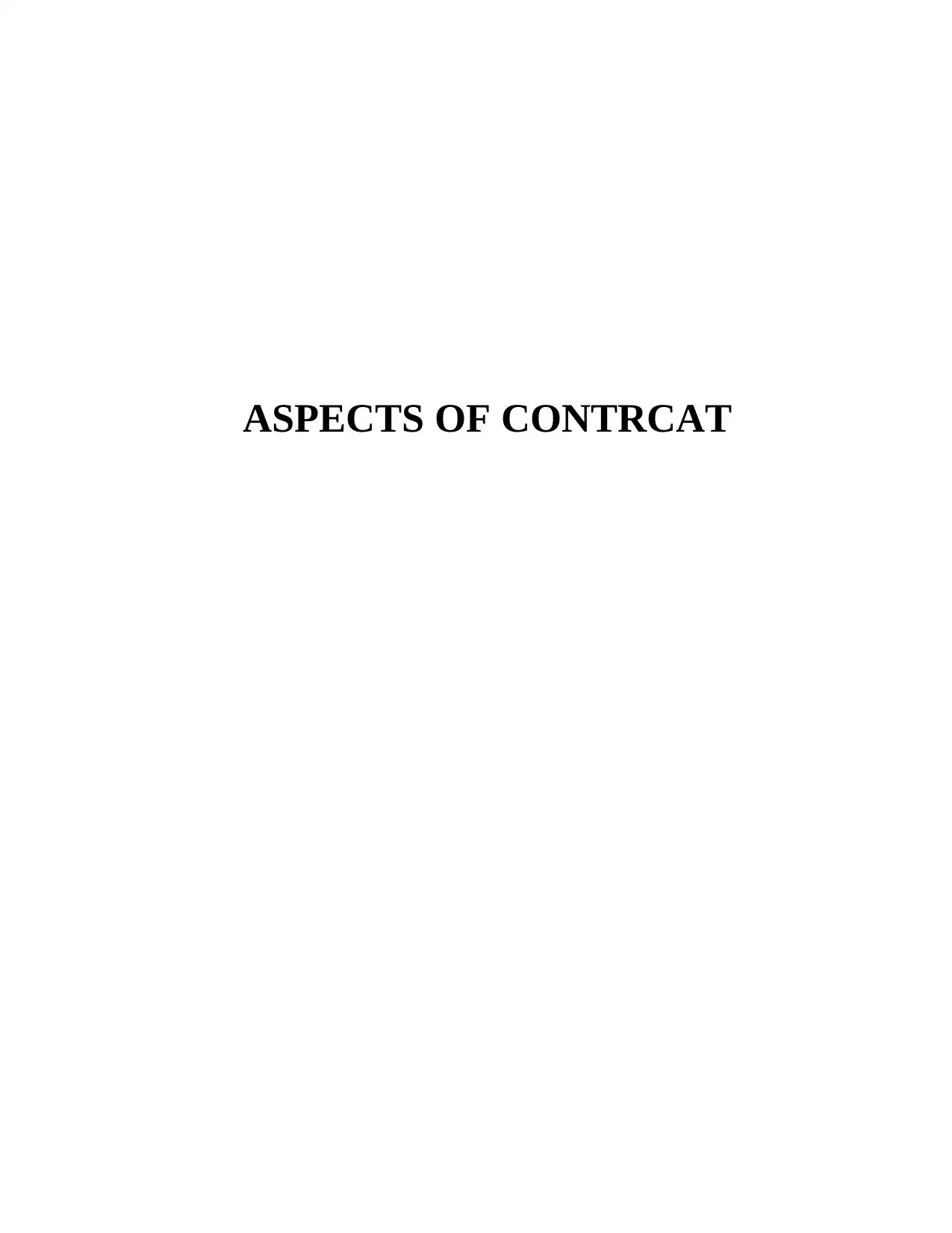
ASPECTS OF CONTRCAT
Paraphrase This Document
Need a fresh take? Get an instant paraphrase of this document with our AI Paraphraser

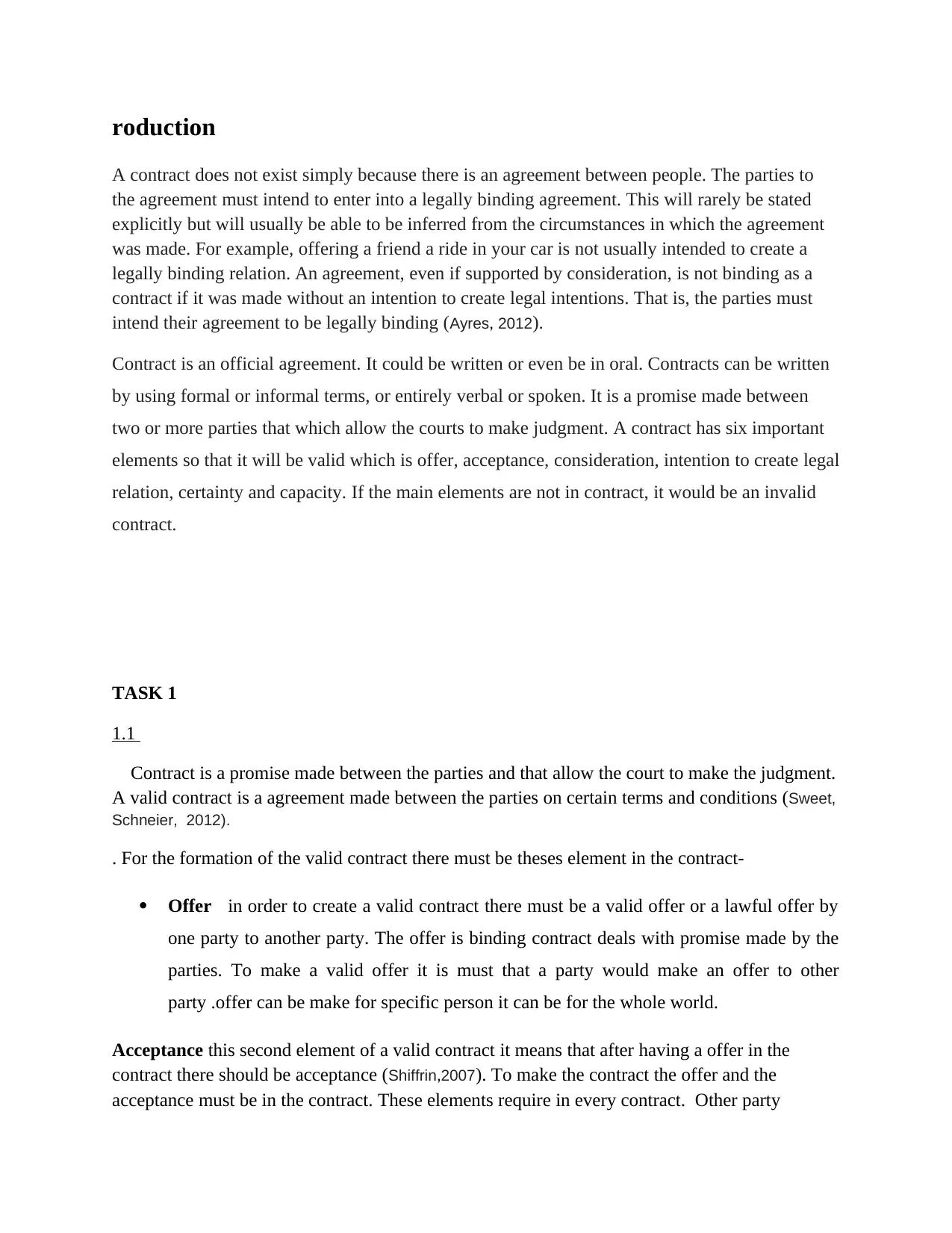
roduction
A contract does not exist simply because there is an agreement between people. The parties to
the agreement must intend to enter into a legally binding agreement. This will rarely be stated
explicitly but will usually be able to be inferred from the circumstances in which the agreement
was made. For example, offering a friend a ride in your car is not usually intended to create a
legally binding relation. An agreement, even if supported by consideration, is not binding as a
contract if it was made without an intention to create legal intentions. That is, the parties must
intend their agreement to be legally binding (Ayres, 2012).
Contract is an official agreement. It could be written or even be in oral. Contracts can be written
by using formal or informal terms, or entirely verbal or spoken. It is a promise made between
two or more parties that which allow the courts to make judgment. A contract has six important
elements so that it will be valid which is offer, acceptance, consideration, intention to create legal
relation, certainty and capacity. If the main elements are not in contract, it would be an invalid
contract.
TASK 1
1.1
Contract is a promise made between the parties and that allow the court to make the judgment.
A valid contract is a agreement made between the parties on certain terms and conditions (Sweet,
Schneier, 2012).
. For the formation of the valid contract there must be theses element in the contract-
Offer in order to create a valid contract there must be a valid offer or a lawful offer by
one party to another party. The offer is binding contract deals with promise made by the
parties. To make a valid offer it is must that a party would make an offer to other
party .offer can be make for specific person it can be for the whole world.
Acceptance this second element of a valid contract it means that after having a offer in the
contract there should be acceptance (Shiffrin,2007). To make the contract the offer and the
acceptance must be in the contract. These elements require in every contract. Other party
A contract does not exist simply because there is an agreement between people. The parties to
the agreement must intend to enter into a legally binding agreement. This will rarely be stated
explicitly but will usually be able to be inferred from the circumstances in which the agreement
was made. For example, offering a friend a ride in your car is not usually intended to create a
legally binding relation. An agreement, even if supported by consideration, is not binding as a
contract if it was made without an intention to create legal intentions. That is, the parties must
intend their agreement to be legally binding (Ayres, 2012).
Contract is an official agreement. It could be written or even be in oral. Contracts can be written
by using formal or informal terms, or entirely verbal or spoken. It is a promise made between
two or more parties that which allow the courts to make judgment. A contract has six important
elements so that it will be valid which is offer, acceptance, consideration, intention to create legal
relation, certainty and capacity. If the main elements are not in contract, it would be an invalid
contract.
TASK 1
1.1
Contract is a promise made between the parties and that allow the court to make the judgment.
A valid contract is a agreement made between the parties on certain terms and conditions (Sweet,
Schneier, 2012).
. For the formation of the valid contract there must be theses element in the contract-
Offer in order to create a valid contract there must be a valid offer or a lawful offer by
one party to another party. The offer is binding contract deals with promise made by the
parties. To make a valid offer it is must that a party would make an offer to other
party .offer can be make for specific person it can be for the whole world.
Acceptance this second element of a valid contract it means that after having a offer in the
contract there should be acceptance (Shiffrin,2007). To make the contract the offer and the
acceptance must be in the contract. These elements require in every contract. Other party
⊘ This is a preview!⊘
Do you want full access?
Subscribe today to unlock all pages.

Trusted by 1+ million students worldwide
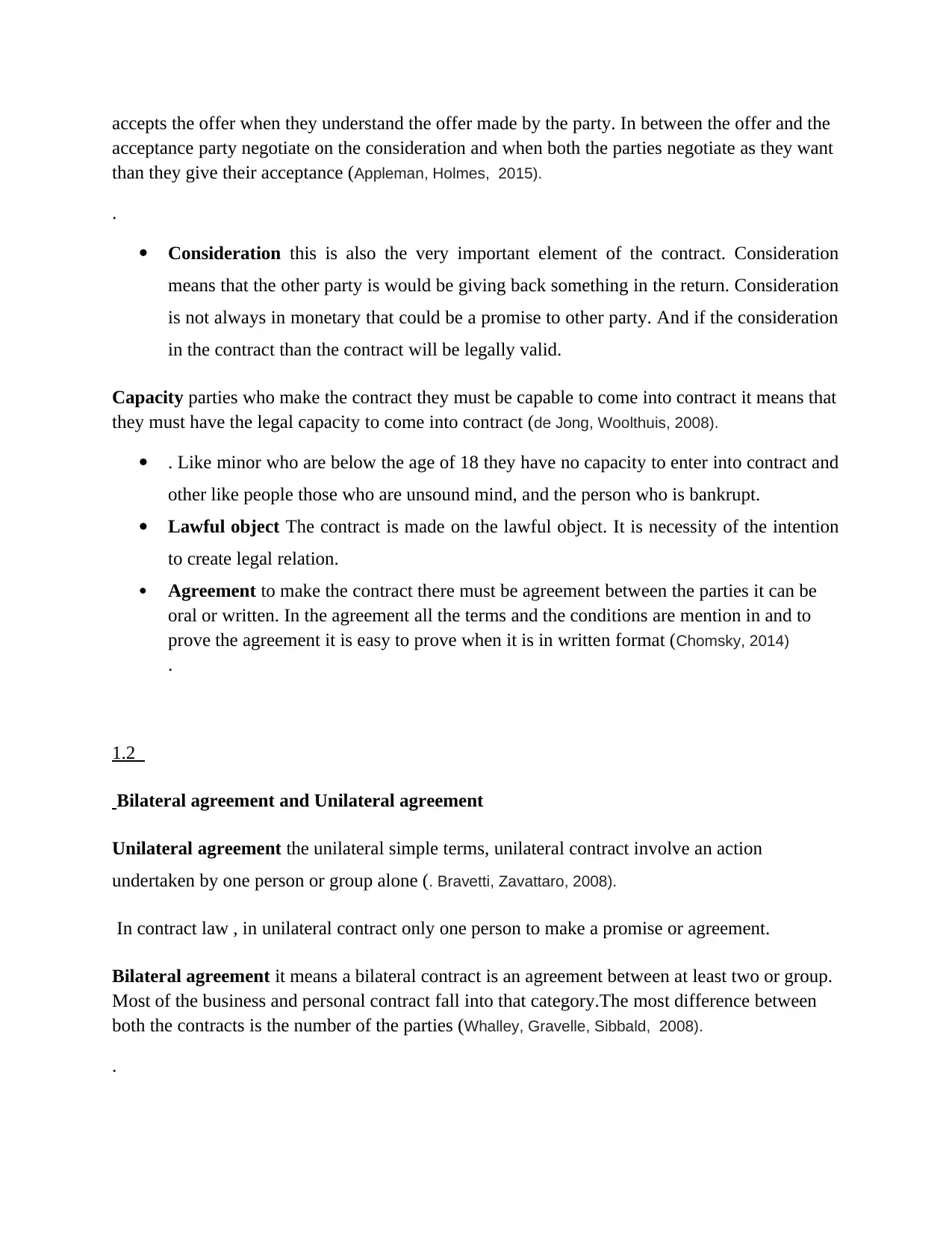
accepts the offer when they understand the offer made by the party. In between the offer and the
acceptance party negotiate on the consideration and when both the parties negotiate as they want
than they give their acceptance (Appleman, Holmes, 2015).
.
Consideration this is also the very important element of the contract. Consideration
means that the other party is would be giving back something in the return. Consideration
is not always in monetary that could be a promise to other party. And if the consideration
in the contract than the contract will be legally valid.
Capacity parties who make the contract they must be capable to come into contract it means that
they must have the legal capacity to come into contract (de Jong, Woolthuis, 2008).
. Like minor who are below the age of 18 they have no capacity to enter into contract and
other like people those who are unsound mind, and the person who is bankrupt.
Lawful object The contract is made on the lawful object. It is necessity of the intention
to create legal relation.
Agreement to make the contract there must be agreement between the parties it can be
oral or written. In the agreement all the terms and the conditions are mention in and to
prove the agreement it is easy to prove when it is in written format (Chomsky, 2014)
.
1.2
Bilateral agreement and Unilateral agreement
Unilateral agreement the unilateral simple terms, unilateral contract involve an action
undertaken by one person or group alone (. Bravetti, Zavattaro, 2008).
In contract law , in unilateral contract only one person to make a promise or agreement.
Bilateral agreement it means a bilateral contract is an agreement between at least two or group.
Most of the business and personal contract fall into that category.The most difference between
both the contracts is the number of the parties (Whalley, Gravelle, Sibbald, 2008).
.
acceptance party negotiate on the consideration and when both the parties negotiate as they want
than they give their acceptance (Appleman, Holmes, 2015).
.
Consideration this is also the very important element of the contract. Consideration
means that the other party is would be giving back something in the return. Consideration
is not always in monetary that could be a promise to other party. And if the consideration
in the contract than the contract will be legally valid.
Capacity parties who make the contract they must be capable to come into contract it means that
they must have the legal capacity to come into contract (de Jong, Woolthuis, 2008).
. Like minor who are below the age of 18 they have no capacity to enter into contract and
other like people those who are unsound mind, and the person who is bankrupt.
Lawful object The contract is made on the lawful object. It is necessity of the intention
to create legal relation.
Agreement to make the contract there must be agreement between the parties it can be
oral or written. In the agreement all the terms and the conditions are mention in and to
prove the agreement it is easy to prove when it is in written format (Chomsky, 2014)
.
1.2
Bilateral agreement and Unilateral agreement
Unilateral agreement the unilateral simple terms, unilateral contract involve an action
undertaken by one person or group alone (. Bravetti, Zavattaro, 2008).
In contract law , in unilateral contract only one person to make a promise or agreement.
Bilateral agreement it means a bilateral contract is an agreement between at least two or group.
Most of the business and personal contract fall into that category.The most difference between
both the contracts is the number of the parties (Whalley, Gravelle, Sibbald, 2008).
.
Paraphrase This Document
Need a fresh take? Get an instant paraphrase of this document with our AI Paraphraser
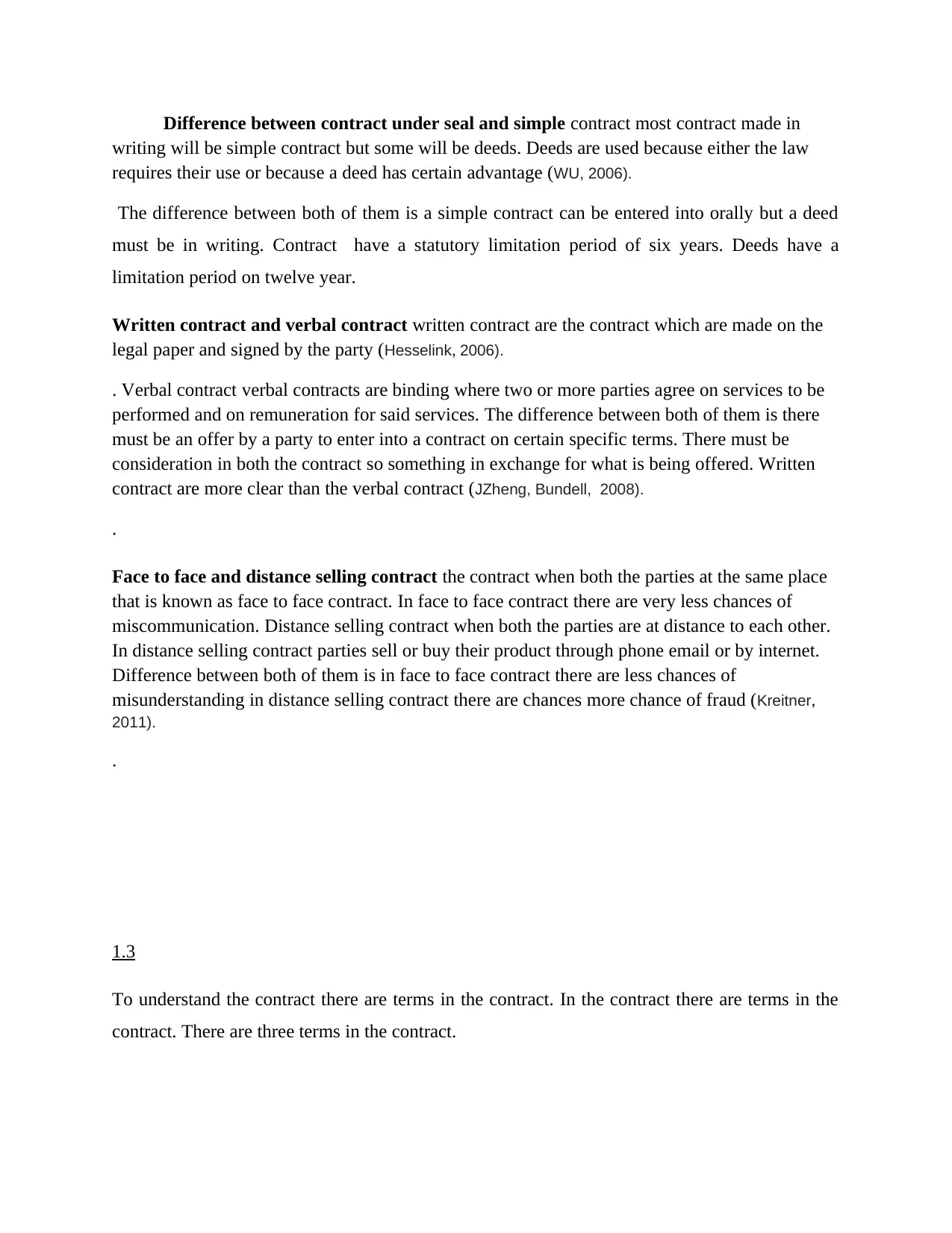
Difference between contract under seal and simple contract most contract made in
writing will be simple contract but some will be deeds. Deeds are used because either the law
requires their use or because a deed has certain advantage (WU, 2006).
The difference between both of them is a simple contract can be entered into orally but a deed
must be in writing. Contract have a statutory limitation period of six years. Deeds have a
limitation period on twelve year.
Written contract and verbal contract written contract are the contract which are made on the
legal paper and signed by the party (Hesselink, 2006).
. Verbal contract verbal contracts are binding where two or more parties agree on services to be
performed and on remuneration for said services. The difference between both of them is there
must be an offer by a party to enter into a contract on certain specific terms. There must be
consideration in both the contract so something in exchange for what is being offered. Written
contract are more clear than the verbal contract (JZheng, Bundell, 2008).
.
Face to face and distance selling contract the contract when both the parties at the same place
that is known as face to face contract. In face to face contract there are very less chances of
miscommunication. Distance selling contract when both the parties are at distance to each other.
In distance selling contract parties sell or buy their product through phone email or by internet.
Difference between both of them is in face to face contract there are less chances of
misunderstanding in distance selling contract there are chances more chance of fraud (Kreitner,
2011).
.
1.3
To understand the contract there are terms in the contract. In the contract there are terms in the
contract. There are three terms in the contract.
writing will be simple contract but some will be deeds. Deeds are used because either the law
requires their use or because a deed has certain advantage (WU, 2006).
The difference between both of them is a simple contract can be entered into orally but a deed
must be in writing. Contract have a statutory limitation period of six years. Deeds have a
limitation period on twelve year.
Written contract and verbal contract written contract are the contract which are made on the
legal paper and signed by the party (Hesselink, 2006).
. Verbal contract verbal contracts are binding where two or more parties agree on services to be
performed and on remuneration for said services. The difference between both of them is there
must be an offer by a party to enter into a contract on certain specific terms. There must be
consideration in both the contract so something in exchange for what is being offered. Written
contract are more clear than the verbal contract (JZheng, Bundell, 2008).
.
Face to face and distance selling contract the contract when both the parties at the same place
that is known as face to face contract. In face to face contract there are very less chances of
miscommunication. Distance selling contract when both the parties are at distance to each other.
In distance selling contract parties sell or buy their product through phone email or by internet.
Difference between both of them is in face to face contract there are less chances of
misunderstanding in distance selling contract there are chances more chance of fraud (Kreitner,
2011).
.
1.3
To understand the contract there are terms in the contract. In the contract there are terms in the
contract. There are three terms in the contract.
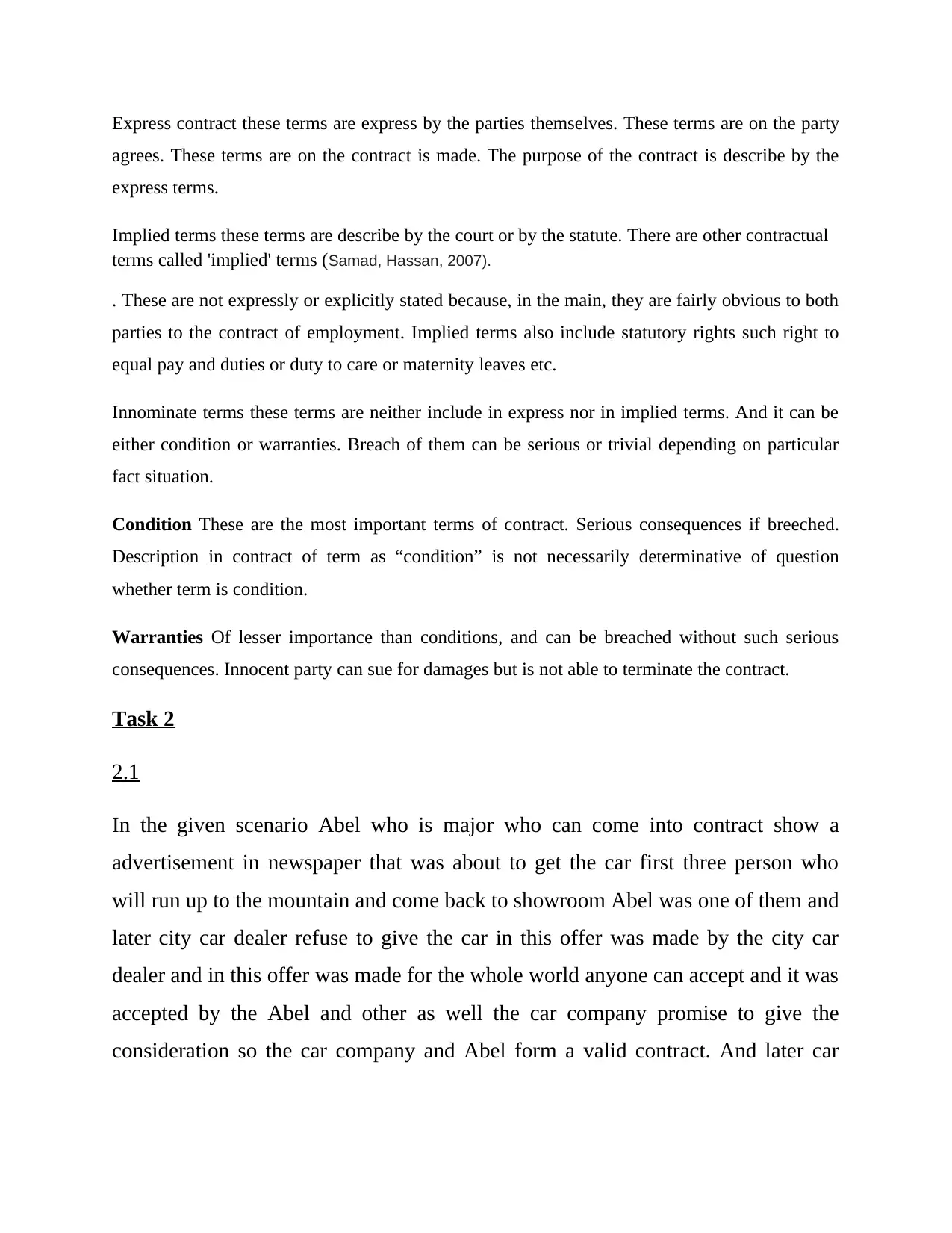
Express contract these terms are express by the parties themselves. These terms are on the party
agrees. These terms are on the contract is made. The purpose of the contract is describe by the
express terms.
Implied terms these terms are describe by the court or by the statute. There are other contractual
terms called 'implied' terms (Samad, Hassan, 2007).
. These are not expressly or explicitly stated because, in the main, they are fairly obvious to both
parties to the contract of employment. Implied terms also include statutory rights such right to
equal pay and duties or duty to care or maternity leaves etc.
Innominate terms these terms are neither include in express nor in implied terms. And it can be
either condition or warranties. Breach of them can be serious or trivial depending on particular
fact situation.
Condition These are the most important terms of contract. Serious consequences if breeched.
Description in contract of term as “condition” is not necessarily determinative of question
whether term is condition.
Warranties Of lesser importance than conditions, and can be breached without such serious
consequences. Innocent party can sue for damages but is not able to terminate the contract.
Task 2
2.1
In the given scenario Abel who is major who can come into contract show a
advertisement in newspaper that was about to get the car first three person who
will run up to the mountain and come back to showroom Abel was one of them and
later city car dealer refuse to give the car in this offer was made by the city car
dealer and in this offer was made for the whole world anyone can accept and it was
accepted by the Abel and other as well the car company promise to give the
consideration so the car company and Abel form a valid contract. And later car
agrees. These terms are on the contract is made. The purpose of the contract is describe by the
express terms.
Implied terms these terms are describe by the court or by the statute. There are other contractual
terms called 'implied' terms (Samad, Hassan, 2007).
. These are not expressly or explicitly stated because, in the main, they are fairly obvious to both
parties to the contract of employment. Implied terms also include statutory rights such right to
equal pay and duties or duty to care or maternity leaves etc.
Innominate terms these terms are neither include in express nor in implied terms. And it can be
either condition or warranties. Breach of them can be serious or trivial depending on particular
fact situation.
Condition These are the most important terms of contract. Serious consequences if breeched.
Description in contract of term as “condition” is not necessarily determinative of question
whether term is condition.
Warranties Of lesser importance than conditions, and can be breached without such serious
consequences. Innocent party can sue for damages but is not able to terminate the contract.
Task 2
2.1
In the given scenario Abel who is major who can come into contract show a
advertisement in newspaper that was about to get the car first three person who
will run up to the mountain and come back to showroom Abel was one of them and
later city car dealer refuse to give the car in this offer was made by the city car
dealer and in this offer was made for the whole world anyone can accept and it was
accepted by the Abel and other as well the car company promise to give the
consideration so the car company and Abel form a valid contract. And later car
⊘ This is a preview!⊘
Do you want full access?
Subscribe today to unlock all pages.

Trusted by 1+ million students worldwide
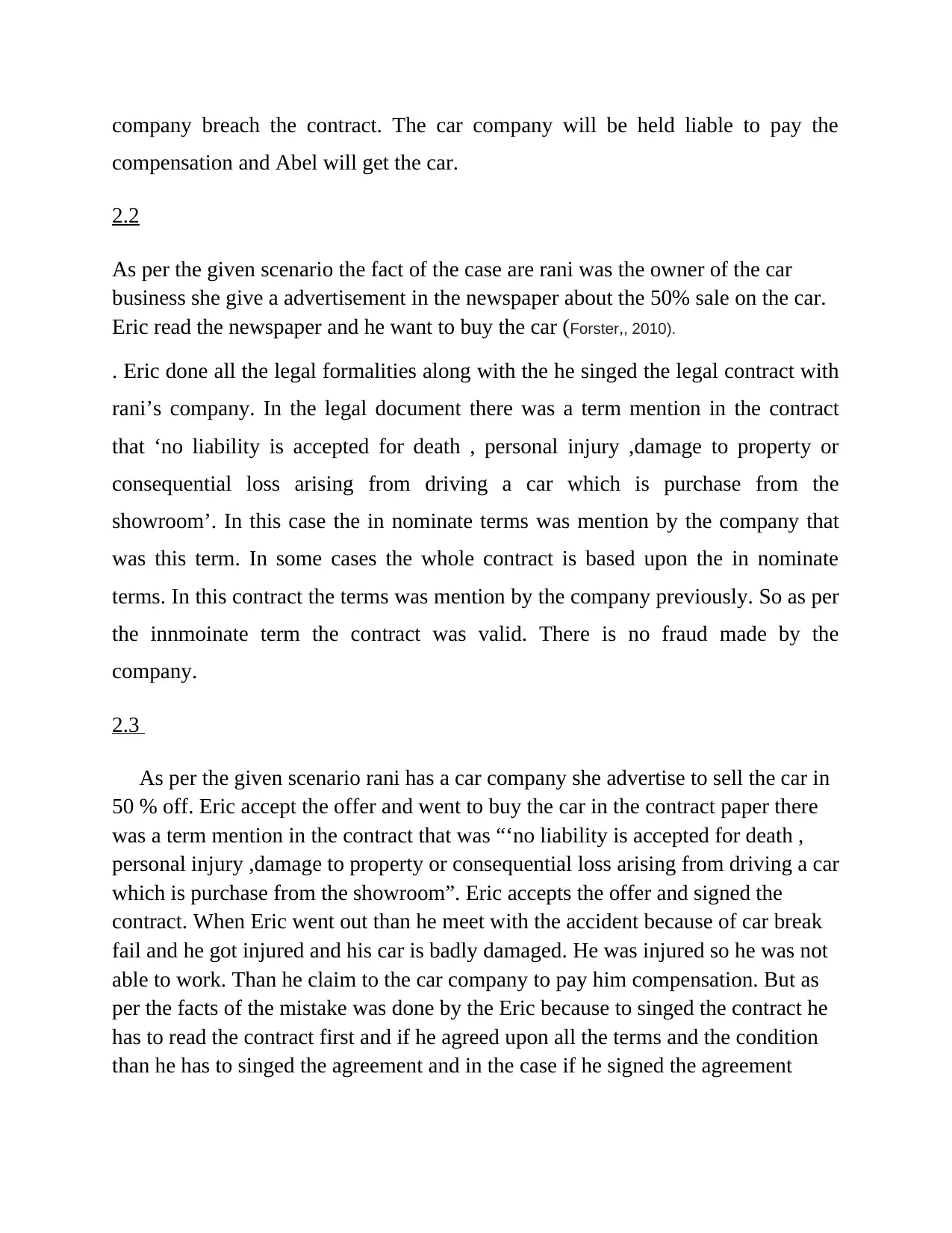
company breach the contract. The car company will be held liable to pay the
compensation and Abel will get the car.
2.2
As per the given scenario the fact of the case are rani was the owner of the car
business she give a advertisement in the newspaper about the 50% sale on the car.
Eric read the newspaper and he want to buy the car (Forster,, 2010).
. Eric done all the legal formalities along with the he singed the legal contract with
rani’s company. In the legal document there was a term mention in the contract
that ‘no liability is accepted for death , personal injury ,damage to property or
consequential loss arising from driving a car which is purchase from the
showroom’. In this case the in nominate terms was mention by the company that
was this term. In some cases the whole contract is based upon the in nominate
terms. In this contract the terms was mention by the company previously. So as per
the innmoinate term the contract was valid. There is no fraud made by the
company.
2.3
As per the given scenario rani has a car company she advertise to sell the car in
50 % off. Eric accept the offer and went to buy the car in the contract paper there
was a term mention in the contract that was “‘no liability is accepted for death ,
personal injury ,damage to property or consequential loss arising from driving a car
which is purchase from the showroom”. Eric accepts the offer and signed the
contract. When Eric went out than he meet with the accident because of car break
fail and he got injured and his car is badly damaged. He was injured so he was not
able to work. Than he claim to the car company to pay him compensation. But as
per the facts of the mistake was done by the Eric because to singed the contract he
has to read the contract first and if he agreed upon all the terms and the condition
than he has to singed the agreement and in the case if he signed the agreement
compensation and Abel will get the car.
2.2
As per the given scenario the fact of the case are rani was the owner of the car
business she give a advertisement in the newspaper about the 50% sale on the car.
Eric read the newspaper and he want to buy the car (Forster,, 2010).
. Eric done all the legal formalities along with the he singed the legal contract with
rani’s company. In the legal document there was a term mention in the contract
that ‘no liability is accepted for death , personal injury ,damage to property or
consequential loss arising from driving a car which is purchase from the
showroom’. In this case the in nominate terms was mention by the company that
was this term. In some cases the whole contract is based upon the in nominate
terms. In this contract the terms was mention by the company previously. So as per
the innmoinate term the contract was valid. There is no fraud made by the
company.
2.3
As per the given scenario rani has a car company she advertise to sell the car in
50 % off. Eric accept the offer and went to buy the car in the contract paper there
was a term mention in the contract that was “‘no liability is accepted for death ,
personal injury ,damage to property or consequential loss arising from driving a car
which is purchase from the showroom”. Eric accepts the offer and signed the
contract. When Eric went out than he meet with the accident because of car break
fail and he got injured and his car is badly damaged. He was injured so he was not
able to work. Than he claim to the car company to pay him compensation. But as
per the facts of the mistake was done by the Eric because to singed the contract he
has to read the contract first and if he agreed upon all the terms and the condition
than he has to singed the agreement and in the case if he signed the agreement
Paraphrase This Document
Need a fresh take? Get an instant paraphrase of this document with our AI Paraphraser
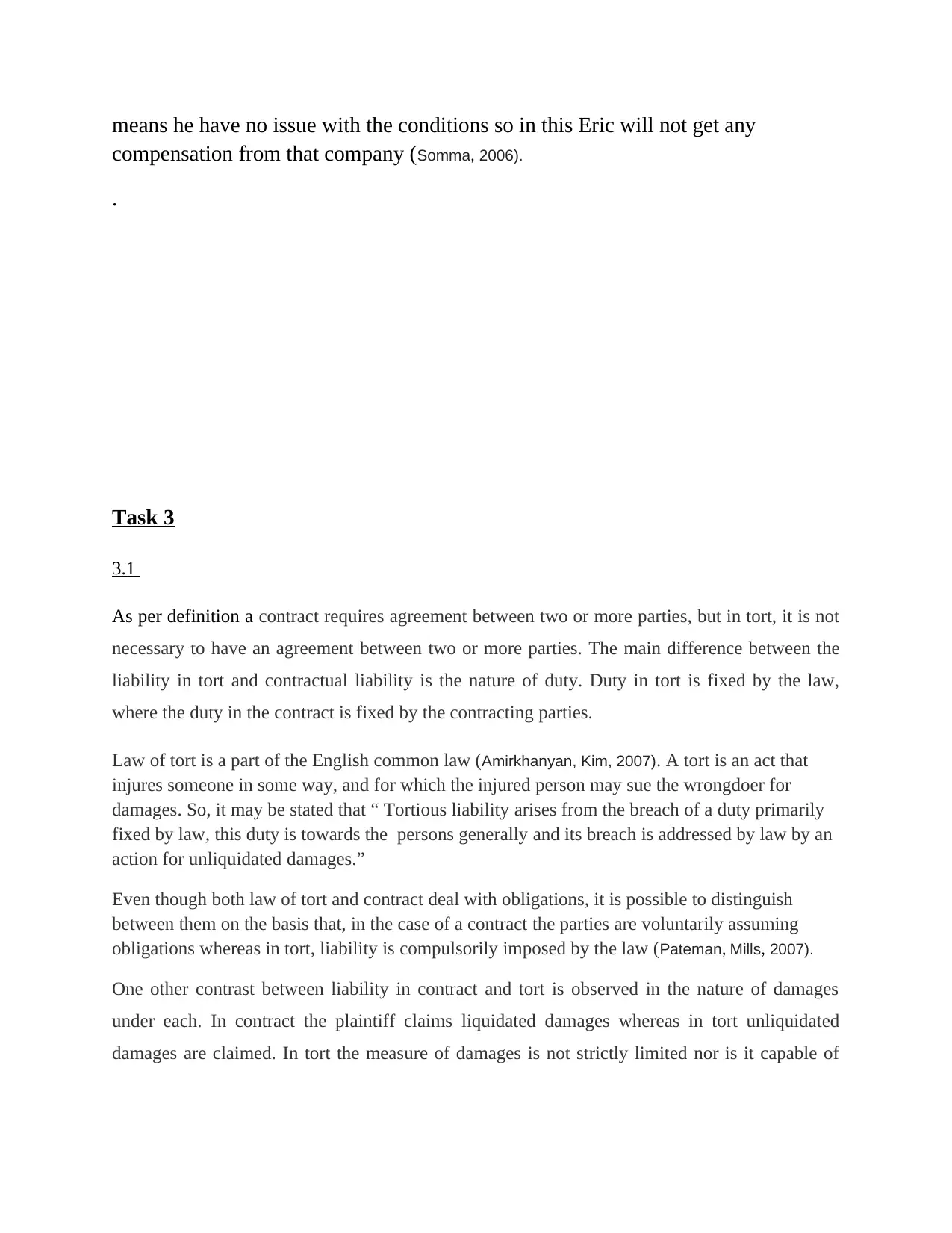
means he have no issue with the conditions so in this Eric will not get any
compensation from that company (Somma, 2006).
.
Task 3
3.1
As per definition a contract requires agreement between two or more parties, but in tort, it is not
necessary to have an agreement between two or more parties. The main difference between the
liability in tort and contractual liability is the nature of duty. Duty in tort is fixed by the law,
where the duty in the contract is fixed by the contracting parties.
Law of tort is a part of the English common law (Amirkhanyan, Kim, 2007). A tort is an act that
injures someone in some way, and for which the injured person may sue the wrongdoer for
damages. So, it may be stated that “ Tortious liability arises from the breach of a duty primarily
fixed by law, this duty is towards the persons generally and its breach is addressed by law by an
action for unliquidated damages.”
Even though both law of tort and contract deal with obligations, it is possible to distinguish
between them on the basis that, in the case of a contract the parties are voluntarily assuming
obligations whereas in tort, liability is compulsorily imposed by the law (Pateman, Mills, 2007).
One other contrast between liability in contract and tort is observed in the nature of damages
under each. In contract the plaintiff claims liquidated damages whereas in tort unliquidated
damages are claimed. In tort the measure of damages is not strictly limited nor is it capable of
compensation from that company (Somma, 2006).
.
Task 3
3.1
As per definition a contract requires agreement between two or more parties, but in tort, it is not
necessary to have an agreement between two or more parties. The main difference between the
liability in tort and contractual liability is the nature of duty. Duty in tort is fixed by the law,
where the duty in the contract is fixed by the contracting parties.
Law of tort is a part of the English common law (Amirkhanyan, Kim, 2007). A tort is an act that
injures someone in some way, and for which the injured person may sue the wrongdoer for
damages. So, it may be stated that “ Tortious liability arises from the breach of a duty primarily
fixed by law, this duty is towards the persons generally and its breach is addressed by law by an
action for unliquidated damages.”
Even though both law of tort and contract deal with obligations, it is possible to distinguish
between them on the basis that, in the case of a contract the parties are voluntarily assuming
obligations whereas in tort, liability is compulsorily imposed by the law (Pateman, Mills, 2007).
One other contrast between liability in contract and tort is observed in the nature of damages
under each. In contract the plaintiff claims liquidated damages whereas in tort unliquidated
damages are claimed. In tort the measure of damages is not strictly limited nor is it capable of
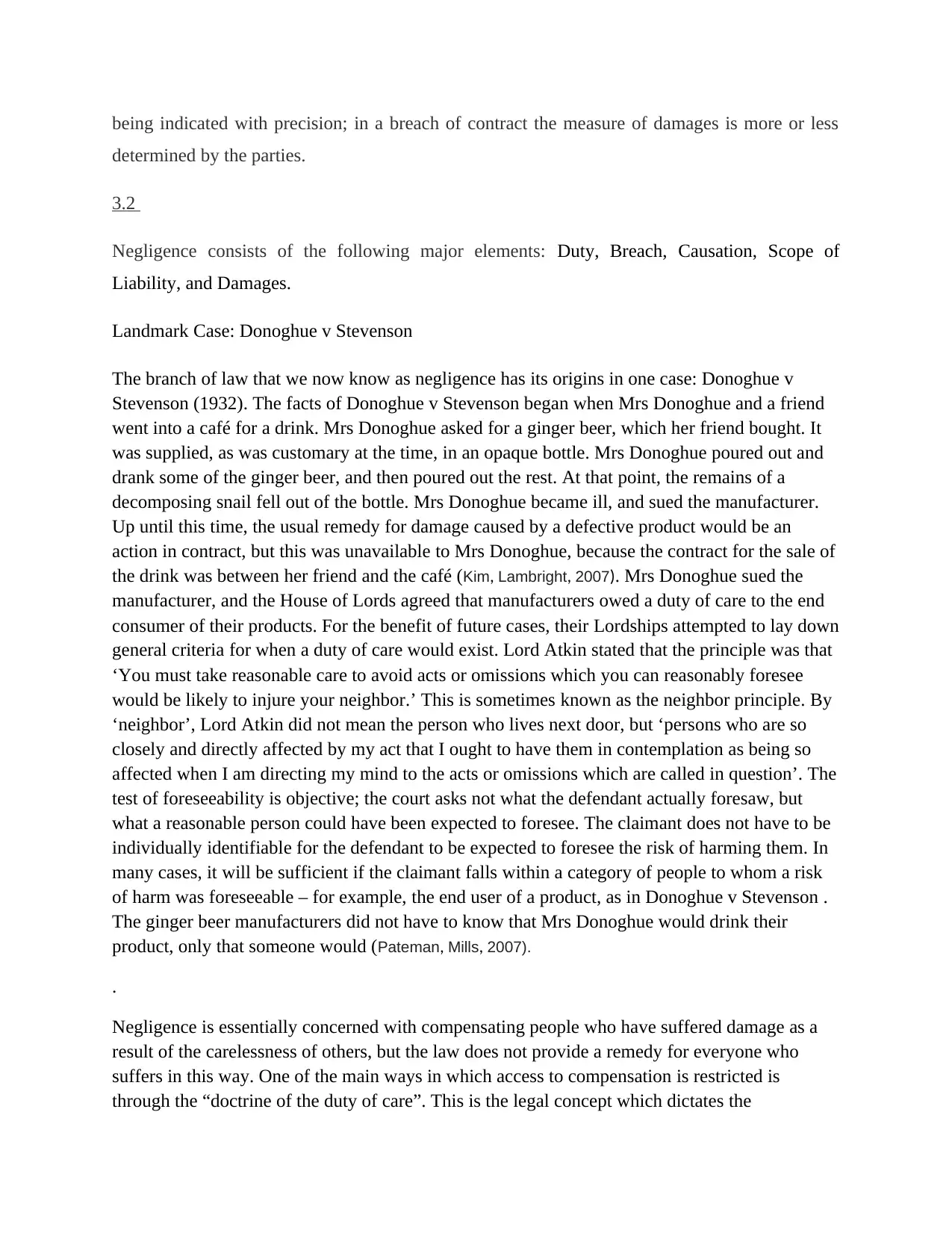
being indicated with precision; in a breach of contract the measure of damages is more or less
determined by the parties.
3.2
Negligence consists of the following major elements: Duty, Breach, Causation, Scope of
Liability, and Damages.
Landmark Case: Donoghue v Stevenson
The branch of law that we now know as negligence has its origins in one case: Donoghue v
Stevenson (1932). The facts of Donoghue v Stevenson began when Mrs Donoghue and a friend
went into a café for a drink. Mrs Donoghue asked for a ginger beer, which her friend bought. It
was supplied, as was customary at the time, in an opaque bottle. Mrs Donoghue poured out and
drank some of the ginger beer, and then poured out the rest. At that point, the remains of a
decomposing snail fell out of the bottle. Mrs Donoghue became ill, and sued the manufacturer.
Up until this time, the usual remedy for damage caused by a defective product would be an
action in contract, but this was unavailable to Mrs Donoghue, because the contract for the sale of
the drink was between her friend and the café (Kim, Lambright, 2007). Mrs Donoghue sued the
manufacturer, and the House of Lords agreed that manufacturers owed a duty of care to the end
consumer of their products. For the benefit of future cases, their Lordships attempted to lay down
general criteria for when a duty of care would exist. Lord Atkin stated that the principle was that
‘You must take reasonable care to avoid acts or omissions which you can reasonably foresee
would be likely to injure your neighbor.’ This is sometimes known as the neighbor principle. By
‘neighbor’, Lord Atkin did not mean the person who lives next door, but ‘persons who are so
closely and directly affected by my act that I ought to have them in contemplation as being so
affected when I am directing my mind to the acts or omissions which are called in question’. The
test of foreseeability is objective; the court asks not what the defendant actually foresaw, but
what a reasonable person could have been expected to foresee. The claimant does not have to be
individually identifiable for the defendant to be expected to foresee the risk of harming them. In
many cases, it will be sufficient if the claimant falls within a category of people to whom a risk
of harm was foreseeable – for example, the end user of a product, as in Donoghue v Stevenson .
The ginger beer manufacturers did not have to know that Mrs Donoghue would drink their
product, only that someone would (Pateman, Mills, 2007).
.
Negligence is essentially concerned with compensating people who have suffered damage as a
result of the carelessness of others, but the law does not provide a remedy for everyone who
suffers in this way. One of the main ways in which access to compensation is restricted is
through the “doctrine of the duty of care”. This is the legal concept which dictates the
determined by the parties.
3.2
Negligence consists of the following major elements: Duty, Breach, Causation, Scope of
Liability, and Damages.
Landmark Case: Donoghue v Stevenson
The branch of law that we now know as negligence has its origins in one case: Donoghue v
Stevenson (1932). The facts of Donoghue v Stevenson began when Mrs Donoghue and a friend
went into a café for a drink. Mrs Donoghue asked for a ginger beer, which her friend bought. It
was supplied, as was customary at the time, in an opaque bottle. Mrs Donoghue poured out and
drank some of the ginger beer, and then poured out the rest. At that point, the remains of a
decomposing snail fell out of the bottle. Mrs Donoghue became ill, and sued the manufacturer.
Up until this time, the usual remedy for damage caused by a defective product would be an
action in contract, but this was unavailable to Mrs Donoghue, because the contract for the sale of
the drink was between her friend and the café (Kim, Lambright, 2007). Mrs Donoghue sued the
manufacturer, and the House of Lords agreed that manufacturers owed a duty of care to the end
consumer of their products. For the benefit of future cases, their Lordships attempted to lay down
general criteria for when a duty of care would exist. Lord Atkin stated that the principle was that
‘You must take reasonable care to avoid acts or omissions which you can reasonably foresee
would be likely to injure your neighbor.’ This is sometimes known as the neighbor principle. By
‘neighbor’, Lord Atkin did not mean the person who lives next door, but ‘persons who are so
closely and directly affected by my act that I ought to have them in contemplation as being so
affected when I am directing my mind to the acts or omissions which are called in question’. The
test of foreseeability is objective; the court asks not what the defendant actually foresaw, but
what a reasonable person could have been expected to foresee. The claimant does not have to be
individually identifiable for the defendant to be expected to foresee the risk of harming them. In
many cases, it will be sufficient if the claimant falls within a category of people to whom a risk
of harm was foreseeable – for example, the end user of a product, as in Donoghue v Stevenson .
The ginger beer manufacturers did not have to know that Mrs Donoghue would drink their
product, only that someone would (Pateman, Mills, 2007).
.
Negligence is essentially concerned with compensating people who have suffered damage as a
result of the carelessness of others, but the law does not provide a remedy for everyone who
suffers in this way. One of the main ways in which access to compensation is restricted is
through the “doctrine of the duty of care”. This is the legal concept which dictates the
⊘ This is a preview!⊘
Do you want full access?
Subscribe today to unlock all pages.

Trusted by 1+ million students worldwide
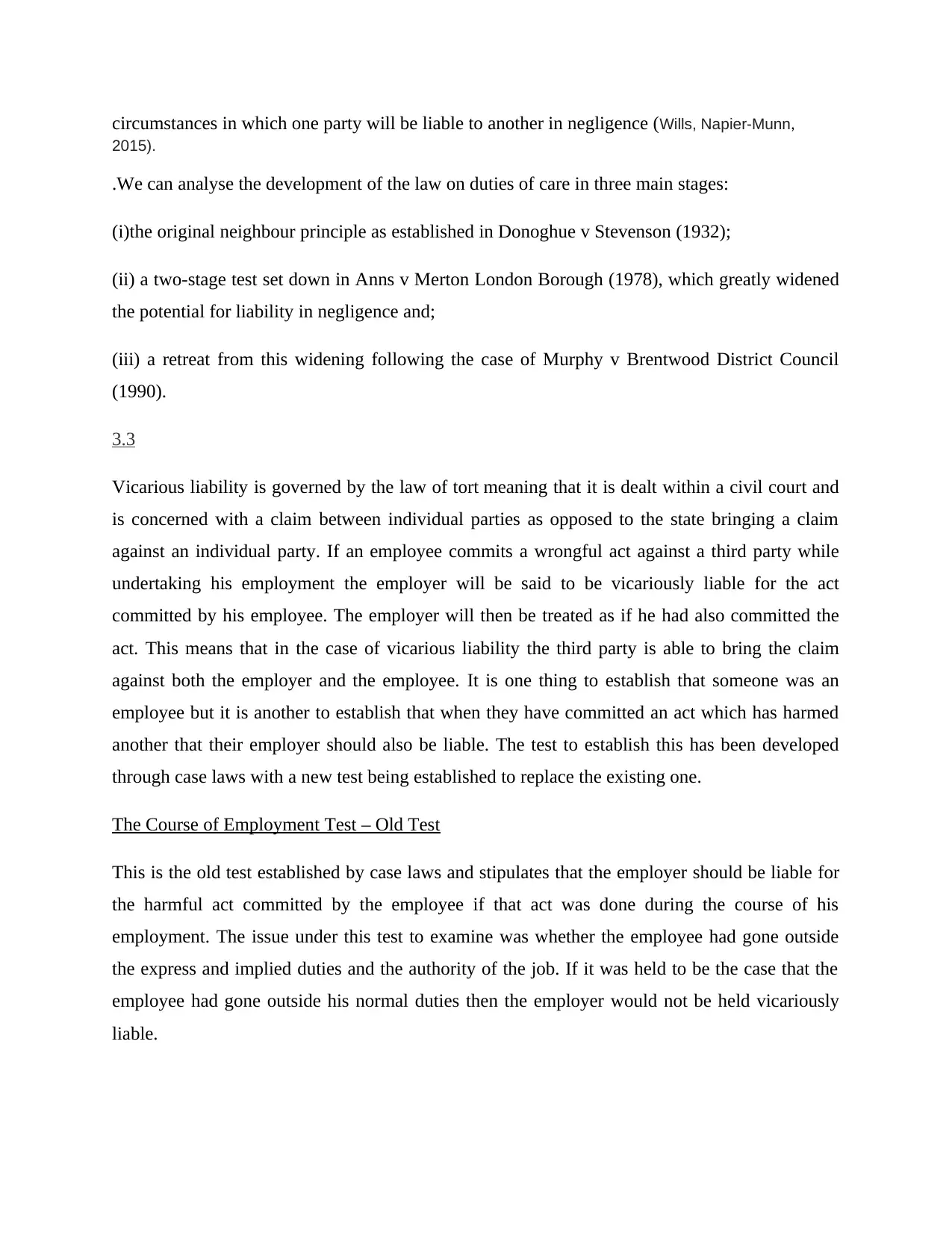
circumstances in which one party will be liable to another in negligence (Wills, Napier-Munn,
2015).
.We can analyse the development of the law on duties of care in three main stages:
(i)the original neighbour principle as established in Donoghue v Stevenson (1932);
(ii) a two-stage test set down in Anns v Merton London Borough (1978), which greatly widened
the potential for liability in negligence and;
(iii) a retreat from this widening following the case of Murphy v Brentwood District Council
(1990).
3.3
Vicarious liability is governed by the law of tort meaning that it is dealt within a civil court and
is concerned with a claim between individual parties as opposed to the state bringing a claim
against an individual party. If an employee commits a wrongful act against a third party while
undertaking his employment the employer will be said to be vicariously liable for the act
committed by his employee. The employer will then be treated as if he had also committed the
act. This means that in the case of vicarious liability the third party is able to bring the claim
against both the employer and the employee. It is one thing to establish that someone was an
employee but it is another to establish that when they have committed an act which has harmed
another that their employer should also be liable. The test to establish this has been developed
through case laws with a new test being established to replace the existing one.
The Course of Employment Test – Old Test
This is the old test established by case laws and stipulates that the employer should be liable for
the harmful act committed by the employee if that act was done during the course of his
employment. The issue under this test to examine was whether the employee had gone outside
the express and implied duties and the authority of the job. If it was held to be the case that the
employee had gone outside his normal duties then the employer would not be held vicariously
liable.
2015).
.We can analyse the development of the law on duties of care in three main stages:
(i)the original neighbour principle as established in Donoghue v Stevenson (1932);
(ii) a two-stage test set down in Anns v Merton London Borough (1978), which greatly widened
the potential for liability in negligence and;
(iii) a retreat from this widening following the case of Murphy v Brentwood District Council
(1990).
3.3
Vicarious liability is governed by the law of tort meaning that it is dealt within a civil court and
is concerned with a claim between individual parties as opposed to the state bringing a claim
against an individual party. If an employee commits a wrongful act against a third party while
undertaking his employment the employer will be said to be vicariously liable for the act
committed by his employee. The employer will then be treated as if he had also committed the
act. This means that in the case of vicarious liability the third party is able to bring the claim
against both the employer and the employee. It is one thing to establish that someone was an
employee but it is another to establish that when they have committed an act which has harmed
another that their employer should also be liable. The test to establish this has been developed
through case laws with a new test being established to replace the existing one.
The Course of Employment Test – Old Test
This is the old test established by case laws and stipulates that the employer should be liable for
the harmful act committed by the employee if that act was done during the course of his
employment. The issue under this test to examine was whether the employee had gone outside
the express and implied duties and the authority of the job. If it was held to be the case that the
employee had gone outside his normal duties then the employer would not be held vicariously
liable.
Paraphrase This Document
Need a fresh take? Get an instant paraphrase of this document with our AI Paraphraser
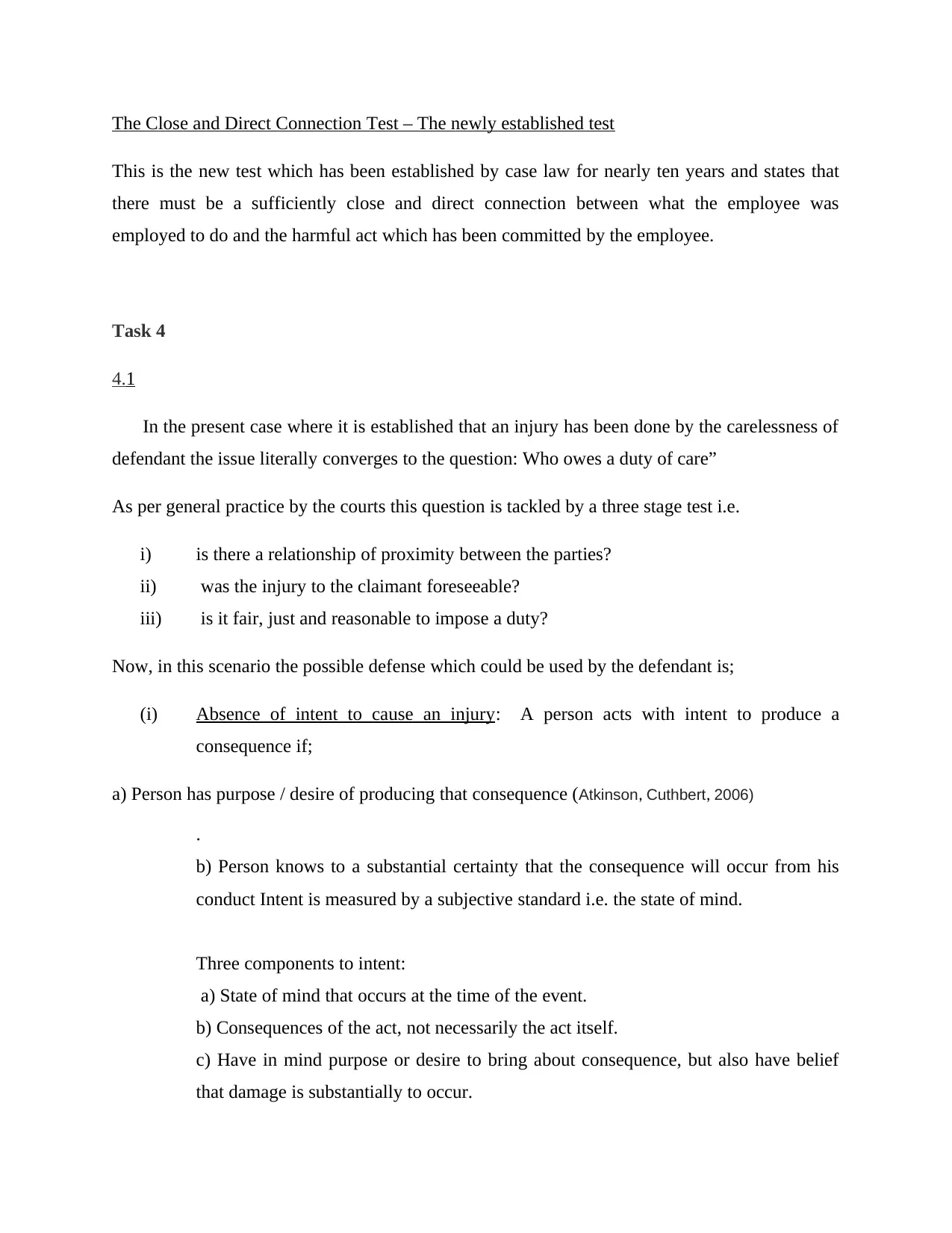
The Close and Direct Connection Test – The newly established test
This is the new test which has been established by case law for nearly ten years and states that
there must be a sufficiently close and direct connection between what the employee was
employed to do and the harmful act which has been committed by the employee.
Task 4
4.1
In the present case where it is established that an injury has been done by the carelessness of
defendant the issue literally converges to the question: Who owes a duty of care”
As per general practice by the courts this question is tackled by a three stage test i.e.
i) is there a relationship of proximity between the parties?
ii) was the injury to the claimant foreseeable?
iii) is it fair, just and reasonable to impose a duty?
Now, in this scenario the possible defense which could be used by the defendant is;
(i) Absence of intent to cause an injury: A person acts with intent to produce a
consequence if;
a) Person has purpose / desire of producing that consequence (Atkinson, Cuthbert, 2006)
.
b) Person knows to a substantial certainty that the consequence will occur from his
conduct Intent is measured by a subjective standard i.e. the state of mind.
Three components to intent:
a) State of mind that occurs at the time of the event.
b) Consequences of the act, not necessarily the act itself.
c) Have in mind purpose or desire to bring about consequence, but also have belief
that damage is substantially to occur.
This is the new test which has been established by case law for nearly ten years and states that
there must be a sufficiently close and direct connection between what the employee was
employed to do and the harmful act which has been committed by the employee.
Task 4
4.1
In the present case where it is established that an injury has been done by the carelessness of
defendant the issue literally converges to the question: Who owes a duty of care”
As per general practice by the courts this question is tackled by a three stage test i.e.
i) is there a relationship of proximity between the parties?
ii) was the injury to the claimant foreseeable?
iii) is it fair, just and reasonable to impose a duty?
Now, in this scenario the possible defense which could be used by the defendant is;
(i) Absence of intent to cause an injury: A person acts with intent to produce a
consequence if;
a) Person has purpose / desire of producing that consequence (Atkinson, Cuthbert, 2006)
.
b) Person knows to a substantial certainty that the consequence will occur from his
conduct Intent is measured by a subjective standard i.e. the state of mind.
Three components to intent:
a) State of mind that occurs at the time of the event.
b) Consequences of the act, not necessarily the act itself.
c) Have in mind purpose or desire to bring about consequence, but also have belief
that damage is substantially to occur.
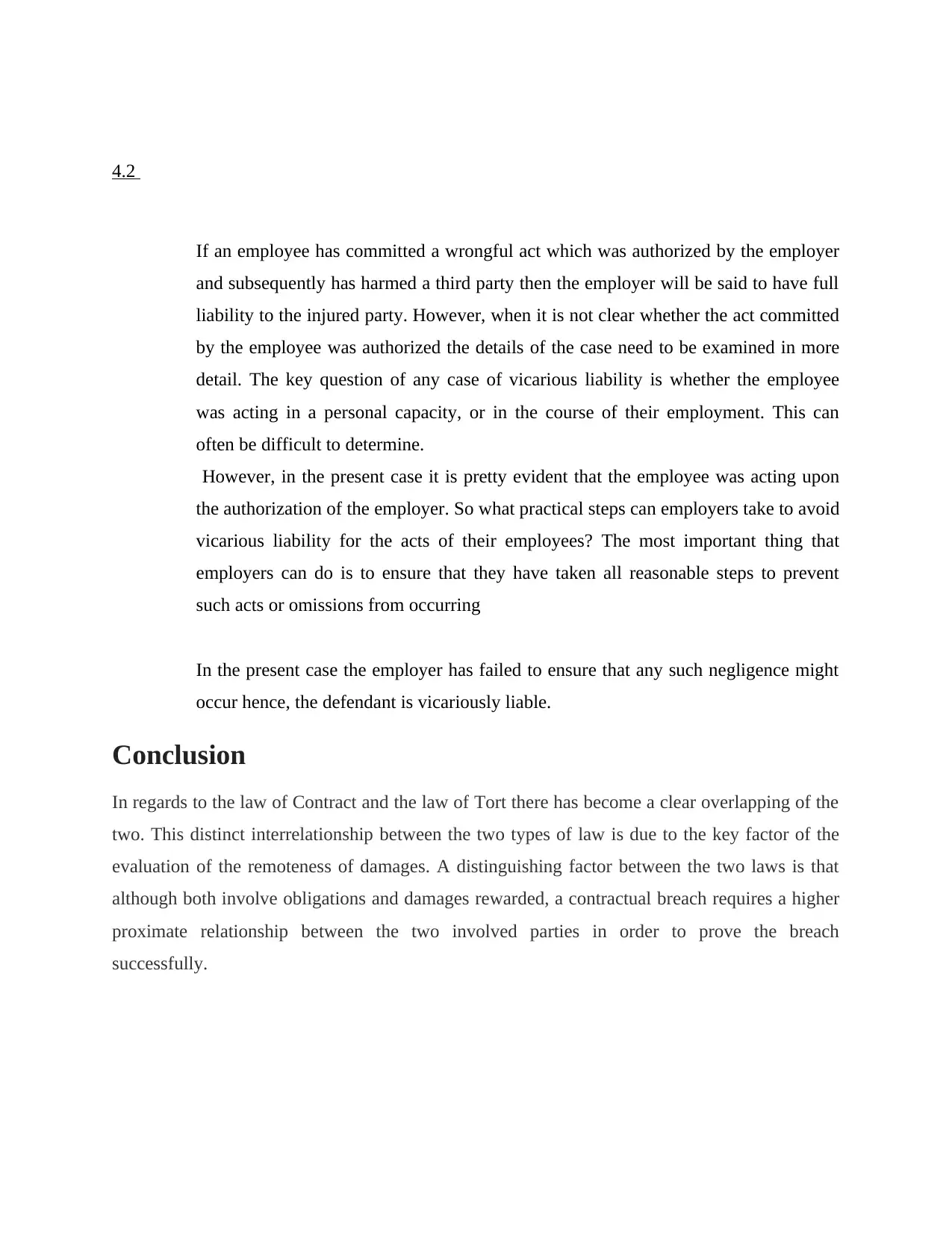
4.2
If an employee has committed a wrongful act which was authorized by the employer
and subsequently has harmed a third party then the employer will be said to have full
liability to the injured party. However, when it is not clear whether the act committed
by the employee was authorized the details of the case need to be examined in more
detail. The key question of any case of vicarious liability is whether the employee
was acting in a personal capacity, or in the course of their employment. This can
often be difficult to determine.
However, in the present case it is pretty evident that the employee was acting upon
the authorization of the employer. So what practical steps can employers take to avoid
vicarious liability for the acts of their employees? The most important thing that
employers can do is to ensure that they have taken all reasonable steps to prevent
such acts or omissions from occurring
In the present case the employer has failed to ensure that any such negligence might
occur hence, the defendant is vicariously liable.
Conclusion
In regards to the law of Contract and the law of Tort there has become a clear overlapping of the
two. This distinct interrelationship between the two types of law is due to the key factor of the
evaluation of the remoteness of damages. A distinguishing factor between the two laws is that
although both involve obligations and damages rewarded, a contractual breach requires a higher
proximate relationship between the two involved parties in order to prove the breach
successfully.
If an employee has committed a wrongful act which was authorized by the employer
and subsequently has harmed a third party then the employer will be said to have full
liability to the injured party. However, when it is not clear whether the act committed
by the employee was authorized the details of the case need to be examined in more
detail. The key question of any case of vicarious liability is whether the employee
was acting in a personal capacity, or in the course of their employment. This can
often be difficult to determine.
However, in the present case it is pretty evident that the employee was acting upon
the authorization of the employer. So what practical steps can employers take to avoid
vicarious liability for the acts of their employees? The most important thing that
employers can do is to ensure that they have taken all reasonable steps to prevent
such acts or omissions from occurring
In the present case the employer has failed to ensure that any such negligence might
occur hence, the defendant is vicariously liable.
Conclusion
In regards to the law of Contract and the law of Tort there has become a clear overlapping of the
two. This distinct interrelationship between the two types of law is due to the key factor of the
evaluation of the remoteness of damages. A distinguishing factor between the two laws is that
although both involve obligations and damages rewarded, a contractual breach requires a higher
proximate relationship between the two involved parties in order to prove the breach
successfully.
⊘ This is a preview!⊘
Do you want full access?
Subscribe today to unlock all pages.

Trusted by 1+ million students worldwide
1 out of 14
Related Documents
Your All-in-One AI-Powered Toolkit for Academic Success.
+13062052269
info@desklib.com
Available 24*7 on WhatsApp / Email
![[object Object]](/_next/static/media/star-bottom.7253800d.svg)
Unlock your academic potential
Copyright © 2020–2025 A2Z Services. All Rights Reserved. Developed and managed by ZUCOL.





